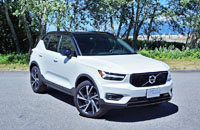
Admittedly, I like Volvo a lot. Specifically the new, reimagined Volvo that arrived on the scene in 2015 with the introduction of the 2016 XC90. Its styling first attracted me, followed by a new level of interior design and quality, which I became aware of once familiarized with the model firsthand. This including improvements made to its Sensus electronics interfaces, and carried forward the Swedish company’s advanced drivetrain philosophy that was initiated in previous models, albeit with greater focus on performance and efficiency via optional plug-in hybrid technology. Of course, safety has always been a Volvo priority, evidenced by its most recent model, this XC40 being reviewed here, which already received a best-possible Top Safety Pick + rating from the IIHS.
The need for full disclosure and honest journalism makes it important for me to mention that the XC90 didn’t earn an IIHS Top Safety Pick + rating for 2019, or for 2018 either. You’ll need to search all the way back to 2016 to see that, while in 2017 it only achieved a Top Safety Pick rating without the “+”, this having everything to do with the IIHS’ continually more challenging standards than anything Volvo has done to detract from XC90 safety. In fact, in 2016 Volvo had five + rated models, with that number having dropped to three in 2017, the missing two having lost their + ratings despite the S80 having transformed into the S90. Model year 2018 saw all five of the same vehicles only given Top Safety Pick ratings, even though the all-new XC60 joined the lineup, and while it seems like a bonus to finally receive another Top Safety Pick + rating for the new XC40 shown on this page, the only other model to even get a Top Safety Pick so far this year is the just noted XC60.
Possibly more important to Volvo and you, this XC40 is the only vehicle in its class to earn a Top Safety Pick + rating, while only two others, BMW’s X2 and Lexus’ new UX, managed to be named Top Safety Picks, excluding the +, so therefore if safety is number one on your list and you want a compact luxury SUV, look no further than this impressive little unit.
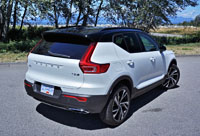
Then again, there are many other reasons to consider an XC40, which incidentally earned 2018 European Car of the Year status, and has become Volvo’s second best-selling model globally (after the larger XC60). The XC40 hits the market with a wonderfully unique and handsome design, particularly in its two-tone exterior colour combos. I spent a week with one in entry-level Momentum trim that I’ll review in in the near future, coated in pretty Amazon Blue with a white roof (arguably more appealing to feminine tastes, but what does that say about me because I really liked it), and I must say it caused a lot of looky-loos to take notice. This Crystal White Pearl Metallic dipped R-Design model, featuring a black-painted rooftop that comes standard with this trim, caused nearly as much ado, plus I must admit that it would be my choice thanks to its sportier, more masculine appearance.
Climb inside any XC40 trim and you’ll quickly find out the XC40 includes all of the premium-level luxury most expect in this fast-growing category. Each front roof pillar is wrapped in high-quality woven cloth, the dash-top and the upper half of each door panel are finished in soft composites, while each armrest gets padded and covered with stitched leatherette, whereas the insides of each door pocket is carpeted (that’s an unusual yet welcome addition), plus they’re big enough to fit a 15-inch laptop plus a large drink bottle. Returning to the pliable plastic surface treatments, there aren’t any below the interior’s midsection, including the front centre console that does include soft painted surfaces above carpeting which covers its lower extremities. Additionally, look upward and you’ll find the same woven fabric used for the front pillars on the ceiling, this wrapped around a big panoramic sunroof featuring a power-actuated translucent sunshade.
The instrument panel typifies modern-day Volvo, which means that it’s a tasteful design with only the most necessary controls included, but this said its designers gave it a bit of unorthodox funk by incorporating four retrospective-style vertically-positioned satin-silver finished aluminum vents, enhanced with stylish textured aluminum trim placed between as well as on the door panels. All of the metal is beautifully finished, particularly the knurled aluminum edging around the circular vent controls, as well as a similar treatment given to the audio volume control knob. All of the XC40’s other knobs, buttons and switches are up to snuff too, even surpassing some of its closest competitors.
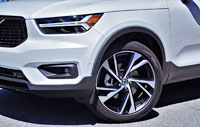
In the same way, this XC40 R-Design’s special contrast-stitched and perforated leather-wrapped sport steering wheel is impeccably finished, even getting some of the aforementioned satin-silver detailing too, while a similarly upscale level of near handmade detail was provided to the electronic transmission’s shifter, as well as seats’ fabulous looking leather and suede-style Nubuck upholstery. Volvo also added a sharp looking set of metal and rubber pedals in the driver’s footwell, making this R-Design the perfect choice for buyers who want a little more sport during their daily commutes.
I found the driver’s seat particularly comfortable, thanks to larger than average side bolsters and an extendable lower cushion that cupped ideally below my knees. The rear seating compartment was comfortable and generously proportioned too, even capable of large six-foot-plus occupants with space to spare. Rear passengers are further comforted with a fold-down centre armrest that doubles as a pass-through for loading in long cargo.
I found the luggage compartment sizeable enough for my requirements throughout my busy week, its 586-litre (20.7 cubic-foot) proportions easily fitting my daily gear, and its 917-litre (32.4 cubic-foot) capacity more than enough when the need came to expand on its abilities. I even tested it out by placing a set of ultra-long 190-cm boards down the middle (used when the need for speed beckons), and had no problem stuffing them inside.
Even better, the 60/40-split rear seatbacks can be lowered by pressing power-release buttons on the cargo wall, while yet more utility can be added by pulling the cargo floor upwards at centre, which forms a handy divider that’s even topped off with a trio of helpful grocery bag hooks. Alternatively the cargo floor can be contorted into a small shelf when the need to increase loadable surface space arises.
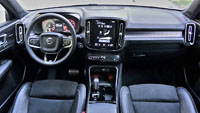
The XC40’s convenience-feature theme continues with a hidden hook that flips out from within the glove box, plus a waste bin within the centre console that can be removed for cleaning, an optional storage box below the driver’s seat, a parking pass holder that butts up against the driver’s side windshield pillar, and gas/credit card slots integrated within the instrument panel just to the left of the driver’s knee.
What’s more, the bottom portion of the centre stack gets a large rubberized platform for holding big smartphones, capable of being upgraded with wireless charging, while there’s room enough to stow sunglasses on either side. Volvo has also included the requisite 12-volt charger (although I can’t remember the last time I used one of these) and a duo of USB ports, one dedicated for Apple CarPlay and Android Auto smartphone integration, and the other just for charging (three USB ports come standard). The XC40 is easily the most conveniently thought out SUV in its subcompact luxury class.
While most of the items just mentioned don’t require much in the way of technical advancements, the XC40’s standard digital gauge cluster is the epitome of modernity. Its 12.3-inch diameter provides a lot of information, while its high-definition display is bright, colourful and crystal clear, plus it comes filled with functions such as optional navigation mapping that fills out most of the centre-mounted multi-information display. Its rivals don’t offer anything as advanced in their standard trims (except the new Lexus UX, but it’s only 7.0 inches in diameter), with most not even providing a digital gauge upgrade at all. This gives the XC40 a serious lead when it comes to electronics.
Even better, Volvo’s award-winning nine-inch Sensus infotainment touchscreen sits vertically atop the centre stack, making it look and work more like tablet than anything else in the class. It responds to touch gestures just like an iPad or Android-based device, including tap, pinch and swipe, plus it does so for more functions than usual. Along with the navigation map, you can also adjust temperature settings with a vertical readout per frontal zone that pops up on the appropriate side of the screen, letting you or your partner slide a finger up or down in order to set ideal heating or cooling.

The touchscreen also allows control of all audio functions including streaming Bluetooth, satellite radio, 4G LTE Wi-Fi, plus more, while my Samsung S9 connected easily, both via Bluetooth and when plugging it in for previously noted Android Auto. It’s an nicely designed interface that’s minimalist on graphics, yet nevertheless one of my favourites, and thanks to being no more difficult to use than a regular smartphone should be easy enough for anyone to operate.
Also on the centre stack, a thin row of premium quality switchgear allows fast prompts to key climate controls, plus a couple of audio functions including the previously noted knurled aluminum-trimmed volume knob, as well as the hazard lights, and lastly a drive mode selector featuring Eco, Comfort, Dynamic, Individual, and optional (not available with the Momentum) Off-road settings.
As noted, navigation isn’t standard either, but rather is optional for $1,000, but the XC40’s standard features menu is long just the same, including most everything mentioned up to this point, as well as LED headlights, roof rails, remote ignition, pushbutton start/stop, a leather-clad multi-function steering wheel rim, an electric parking brake, rain-sensing wipers, an auto-dimming centre mirror, single-zone automatic climate control, voice activation, heatable front seats, a power-adjustable driver’s seat with four-way powered lumbar support and memory settings, genuine aluminum trim, as well as a bevy of active safety features like forward collision warning, autonomous emergency braking, lane departure warning and mitigation, plus more, all of which is once-again enough to earn the IIHS Top Safety Pick + rating mentioned earlier. At just $39,500 plus destination, the XC40 is one of the best values in its luxury crossover category.
The sporty looking XC40 in the photos is an R-Design, which begins a bit higher on the food chain at $44,100. It incorporates all the previously-noted gear as well as a larger set of 19-inch alloys (although my test model was shod in available 20-inch rubber) rolling on a sport-tuned suspension, while additional upgrades including a special front grille with glossy black trim, blackened skid plates, gloss-black mirror caps, and additional black-chrome outer trimmings, plus the black-painted roof top mentioned earlier.
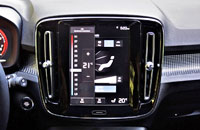
Also, the R-Design gets active cornering headlamps, fog lights, exposed twin exhaust pipes instead of the hidden tailpipes used for the Momentum, unique aluminum front treadplates, nicer carpets, more cabin illumination, dual-zone automatic climate control, a power-adjustable front passenger’s seat, the aforementioned cushion front extensions, the previously-noted panoramic sunroof, a black roofliner and pillars (instead of tan), aluminized cargo sill trim, and more.
Volvo upgraded my test model with a Premium Package as well, including the wireless charging noted before, plus the underseat storage box and grocery bag holders I also mentioned, as well as headlamp washers, power-retractable and auto-dimming outside mirrors, heatable wiper blades, a heated steering wheel rim, heatable rear seats, a power-actuated tailgate, plus Blind Spot Information System with Cross Traffic Alert, all for just $1,750.
Lucky for me, Volvo also added a $2,000 Premium Plus Package that featured an overhead 360-degree “Surround View” parking camera system, a HomeLink universal remote, dynamic cruise control, Volvo’s proprietary Pilot Assist semi-autonomous Driver Assistance System (which is a hands-on semi-self-driving system that aids highway driving nicely), the semi-autonomous Park Assist Pilot parking system featuring Park Assist front and rear sensors, and a 12-volt power outlet in the cargo area; plus the previously noted $1,000 navigation system was included too, along with a superb sounding 600-watt, 14-speaker Harmon-Kardon audio system for $950.
Before Volvo initiated its brand-wide overhaul in 2015, its new powertrain strategy started showing up in then-current models. Dissimilar to any other premium brand, or any major carmaker for that matter, the Chinese-controlled Swedish firm based its entire model lineup on one turbocharged 2.0-litre four-cylinder engine, and then retuned it with both turbocharging and supercharging for mid-range models, and, as introduced with the current XC90, a turbocharged, supercharged and plug-in hybrid variation on the theme, good for 400 horsepower and 400 lb-ft of torque.
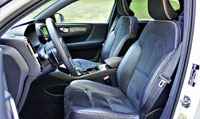
While a 400-horsepower XC40 sounds like a blast, an announcement made back in February promised a plug-in version with making 184-net-kW (247-net-hp) and 328 net-lb-ft of torque due to an electric motor combined with a 1.5-litre three-cylinder gasoline engine driving the front wheels, dubbed the T5 Twin Engine. Reportedly, this should be followed by an XC40 housing an even thriftier T4 Twin Engine, but I’m guessing we’ll only see the more formidable one on this side of the Atlantic… er… the Pacific. Of note, in March Volvo announced that it will reveal a full battery-electric version of the XC40 before the end of this year, which will be part of an initiative for having 50 percent of its worldwide sales comprised of EVs by 2025.
Back in the here and now, Volvo’s second best-selling model globally (after the XC60) is motivated by a 2.0-litre turbocharged four-cylinder good for 248 horsepower and 258 lb-ft of torque, driving all four wheels through an eight-speed automatic gearbox. Next model year (2020) we’ll have the choice of a new base four-cylinder engine, however, still displacing 2.0 litres, once again turbocharged, and continuing to use the eight-speed auto and AWD, but named T4 and making just 187 horsepower and 221 lb-ft of torque. R-Design and Inscription trims will keep the current T5 engine as standard, once again boasting a healthy 248 horsepower and 258 lb-ft of torque.
I have no idea how the new T4 will perform, but my test model’s T5 powertrain is a perfect match to the lightweight XC40, resulting in a quick, well-sorted subcompact crossover SUV. Of course, it’s not the fastest in this category, the Jaguar E-Pace and Range Rover Evoque R-Dynamic siblings housing 296 horsepower under their uniquely shaped bonnets, the new BMW X2 M35i upping the ante with 302 horsepower, and the Mercedes-Benz AMG GLA 45 leading the performance war by a country mile thanks to 375 horsepower behind its three-pointed star.
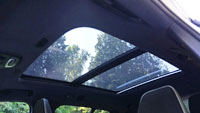
Just the same, the new XC40 has a lot of jump off the line, and despite its eight-speed automatic being a tad frustrating to use, due to the need of having to shift twice before it will engage Drive or Reverse, once underway it responded well, with quick, immediate gear changes, especially when set to “Dynamic” sport mode and when using my R-Design model’s steering wheel-mounted paddles to shift, while it certainly feels confidence-inspiring at speed.
Without doubt my tester’s more performance-oriented 20-inch rubber played its part in gluing chassis to pavement, not to mention this R-Design’s sport suspension upgrade, which is otherwise a fully independent design featuring aluminium double wishbones in front plus a special integral-link setup, with a lightweight composite transverse leaf spring, in back. This meant it hunkered down nicely when pushed quickly through fast-paced curves, and together with its excellent visibility, made point-and-shoot driving a breeze around town.
Being a little SUV, the driver’s seat is positioned taller than what you’d find in a regular car, so along with all the sizeable panes of glass around the greenhouse it made for superb visibility in all directions. That height made it lean a bit more than a car would through corners, but for testing purposes I was traveling much faster than most owners would, and therefore you shouldn’t find this unsettling at all. Also on the positive, the XC40’s brakes are quite strong, responded with stability in regular and panic situations.
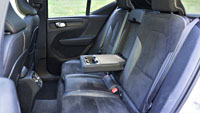
The little Volvo’s ride quality is good for such a compact crossover too, and I really didn’t feel any difference in suspension comfort from the base Momentum model I tried with 18-inch alloys, plus the standard “Dynamic” suspension setup, than this sport-tuned model shod in 20-inch rims. I should also note that Volvo offers up an adaptive Four-C Chassis for another $1,000, but truly I don’t think it’s required unless you spend a lot of time on gravel roads.
In a nutshell, the XC40 comes across as if it’s a larger, more substantive vehicle than it truly is, its doors and liftgate shutting with the sound and solidity of much bigger luxury utilities, plus it’s very quiet inside and exudes impressive build-quality when riding over broken pavement, potholes, bumps, and other obstacles.
Another bonus is fuel efficiency, and not just because it’s a subcompact SUV. It gets a 10.3 L/100km city, 7.5 highway and 9.0 combined Transport Canada rating, which only looks a bit thirsty when compared to a much less powerful, front-wheel drive-infused crossover like the new Lexus UX (which makes a mere 169 horsepower and 151 lb-ft of torque), which achieves 7.2 L/100km combined city/highway with its non-hybrid powerplant. A better comparison to the XC40 is the Mercedes GLA 250 4Matic, which gets an identical combined city/highway rating, while the XC40 is thriftier than BMW’s X1 (9.3 combined), quite a bit better than Jaguar’s base E-Pace P250 (9.8 combined), and a major upgrade over the new Audi Q3 (10.6 combined). Most of the above, including the XC40, utilize auto start/stop technology that automatically turns the engine off when it would otherwise be idling, saving fuel and reducing emissions.
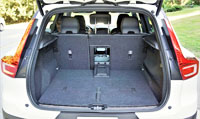
As you can probably tell, this little Volvo SUV impressed me. Despite having other vehicles at my disposal during my test week, I spent more time in its driver’s seat than all the others combined, and couldn’t find much to fault it on. Instead, I believe it’s one of the best compact luxury SUVs in its class, and thoroughly worthy of your close attention.
Story credit: Trevor Hofmann
Photo credit: Karen Tuggay
